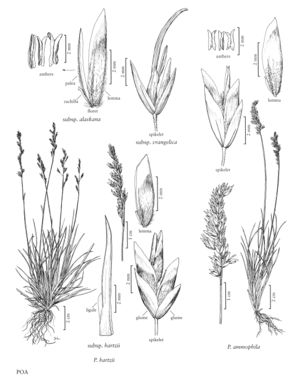familyPoaceae
subfamilyPoaceae subfam. Pooideae
tribePoaceae tribe Poeae
genusPoa
subgenusPoa subg. Poa
sectionPoa sect. Secundae
subsectionPoa subsect. Secundae
speciesPoa hartzii
subspeciesPoa hartzii subsp. alaskana
Difference between revisions of "Poa hartzii subsp. alaskana"
Treatment appears in FNA Volume 24. Treatment on page 591.
imported>Volume Importer |
imported>Volume Importer |
||
| Line 34: | Line 34: | ||
|publication year= | |publication year= | ||
|special status= | |special status= | ||
| − | |source xml=https://bitbucket.org/aafc-mbb/fna-data-curation/src/ | + | |source xml=https://bitbucket.org/aafc-mbb/fna-data-curation/src/200273ad09963decb8fc72550212de541d86569d/coarse_grained_fna_xml/V24/V24_830.xml |
|subfamily=Poaceae subfam. Pooideae | |subfamily=Poaceae subfam. Pooideae | ||
|tribe=Poaceae tribe Poeae | |tribe=Poaceae tribe Poeae | ||
Latest revision as of 17:25, 11 May 2021
Plants loosely tufted. Culms 20-45 cm. Ligules 5-7 mm. Panicles 7-12 cm; branches smooth or sparsely to moderately scabrous. Spikelets 5-7 mm, not bulbiferous, lustrous; florets normal; rachilla internodes 1.5-2 mm. Upper glumes 5-6 mm; calluses usually with a crown of 1-2 mm hairs; lemmas 5.5-7 mm, sparsely hairy, hairs mostly longer than 0.5 mm, apices acute; anthers 2-2.8 mm. 2n = unknown.
Discussion
Poa hartzii subsp. alaskana grows on the North Slope of Alaska, mainly in sandy places. It generally resembles robust plants of P. hartzii subsp. hartzii, but has a looser habit, longer lemmas, and well-developed anthers.
Selected References
None.
Lower Taxa
None.
... more about "Poa hartzii subsp. alaskana"
